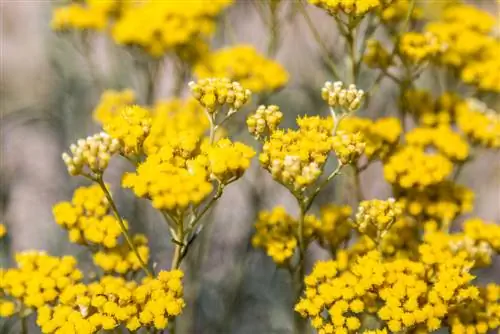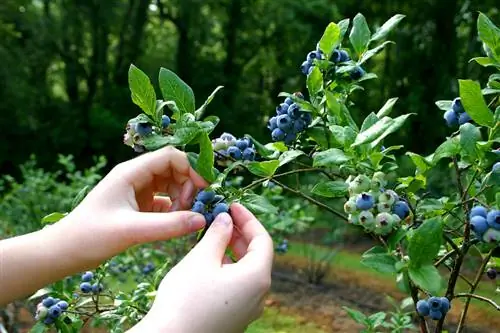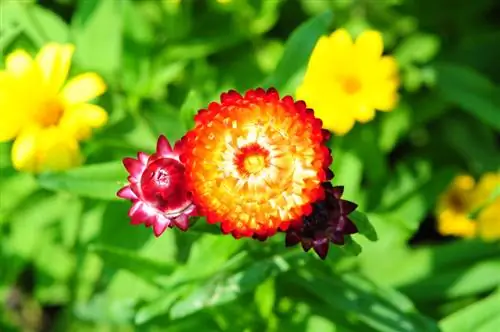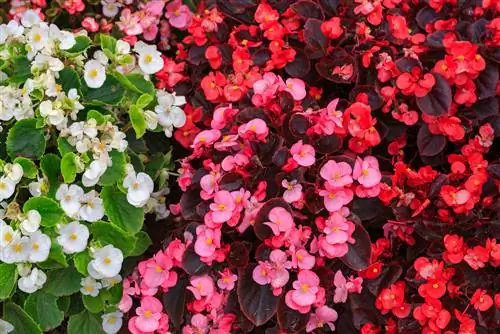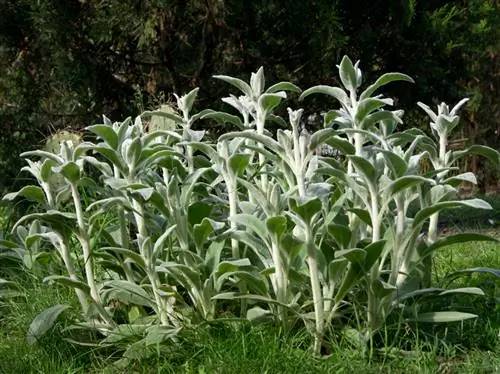- Author admin [email protected].
- Public 2024-01-05 20:48.
- Last modified 2025-01-23 11:21.
Straw flowers with their colorful, ball-shaped basket flowers are very pleasant garden plants - although in this country they are primarily known as an ingredient for dry arrangements. This article explains how you can let the strawflower beautify your home both fresh and dry.
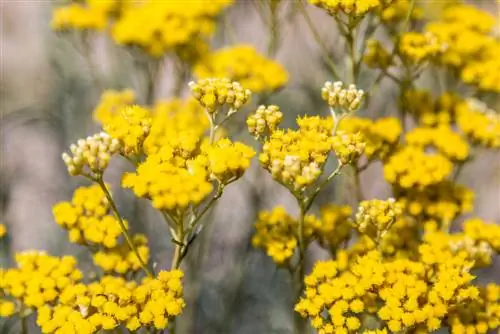
What are everlasting flowers and how do you care for them?
Straw flowers (Helichrysum) are annual or perennial plants valued for their bright, long-lasting flowers in a variety of colors. They thrive in sunny, warm locations and prefer well-drained, humus-rich and nutrient-poor soil. Popular for dried flower bouquets and a variety of garden and pot plantings.
Origin
The strawflower belongs to the daisy family and forms its own genus of plants with the botanical name Helichrysum. This includes an impressive number of around 600 species, of which only a few are cultivated as garden flowers here in Central Europe. This primarily includes the species Helichrysum bractaetum, the garden strawflower. She is originally from Australia.
Overall, the areas of origin of the species-rich strawflower genus are much more extensive and spread across several continents. The majority of the species come from the Cape region of South Africa, a smaller proportion from the Mediterranean region and the Near West and Central Asia as well as from New Zealand.
While strawflowers in their wild form usually grow perennially in their home areas, in this country they are usually cultivated as annuals. Since some species retain their flower color well even when dried, they have established themselves as popular dried bouquet flowers - hence their name.
Origin at a glance:
- Strawflowers form their own plant genus with around 600 species
- Their areas of origin are in Australia, South Africa, the Mediterranean region, Near to Central Asia and New Zealand
- Only a few species cultivated as annual garden plants in this country
- Known for their use in dry bouquets
Growth
The strawflower species that we use as garden plants usually grow as annuals, although many genus species are also perennials or even have a semi-shrubby to shrubby habit. Most species reach a height of between around 20 and 80 centimeters. They usually have an upright, sometimes prostrate stem with tomentose hairs and rich branching. Strawflowers hold themselves in the ground with a taproot and they also form clumps.
Growth characteristics in keywords:
- Species cultivated here are mostly annual, many other species are also perennial, sometimes also with a shrub-like habit
- Height usually between 20 and 80 centimeters
- Upright to prostrate, tomentose-hairy, richly branched stem
- Taproot, clump-forming
leaves
The leaves of the strawflower are fresh green and alternate on the stem. In some species they are stem-encompassing, whereas in the garden strawflower they are only short-stemmed. In the latter species they have an elongated, lanceolate to linear shape; in others they are also egg-shaped or wedge-shaped. The leaf edges are whole. Due to the felty, grayish hairs, the leaves of the garden strawflower have a silky, soft texture on the underside and feel slightly sticky.
Leaf properties in brief:
- Alternative, sometimes encircling stems, sometimes short-stemmed
- lanceolate, linear to ovoid or wedge-shaped contour
- Full margin
- Felty, sticky hair on the underside
Bloom
The flowers, which have a typical basket-shaped appearance, are located at the ends of the branches. In the garden forms they usually stand alone on the upright stems; in the wild forms they are often grouped together in clusters and umbrella clusters. The flowers of most wild forms are yellow in color, but garden varieties have long had a much wider range of colors from whitish pink, bright orange to red, reddish brown and purple.
Flowers at a glance:
- Typical cup-shaped appearance
- In garden forms they are usually single and terminal on the stems, in wild forms they are often clustered in clusters and clusters of umbrellas
- Color originally mostly yellow, in garden species also pink-white to orange, red, reddish brown and purple
Flowering time
The strawflower flowers usually open in July and last until September.
Fruit
So-called achenes with a column-like shape form from the flowers. As with other daisy family plants, such as dandelions, these closing fruits form a pappus - so the seeds get feather-like hairs so that they can be carried on by the wind for sowing.
Which location is suitable?
In its home area, the garden strawflower usually grows in open locations on loamy-sandy to sandy soil. If you want to cultivate it in the garden, offer it a place that is as sunny and warm as possible. Their hunger for light and warmth also makes them ideal as a balcony and patio plant in containers. If you want to cultivate them in the bed together with other plants, place them as far forward as possible so that they always get enough sun.
Site conditions in brief:
- As warm and sunny as possible
- Well suited for balconies and terraces in pots
- Plant far to the front in the bed
hardy
Unlike many of its wild counterparts, the garden strawflower is an annual anyway. The question of winter hardiness doesn't even arise for her.
Some species that are also cultivated here are also perennial, but are often sensitive to frost. These include, for example, the curry herb, also known as the Italian helichrysum (Helichrysum italicum), which is mostly used as a spice plant. The species, which comes from the Mediterranean region, tends not to survive very cold winters, so it should be placed in a cool indoor area in winter.
The South African strawflower (Helichrysum splendidum) is perennial and relatively hardy, but it should still receive some protection in severe frost.
What soil does the plant need?
The strawflower requires relatively nutrient-poor soil with a good proportion of humus. In addition, an effective drainage layer should be incorporated into the substrate, especially when kept in containers. Add a good amount of sand or a small amount of expanded clay to the soil.
To remember:
- Soil should be low in nutrients but rich in humus
- Good permeability through drainage with sand or expanded clay
Watering straw flowers
In outdoor cultivation, you don't necessarily need to water strawflowers separately; they tolerate dryness much better than too much wetness. If you grow them in a bucket, regular watering is necessary, but it should be moderate. Make sure to avoid waterlogging and empty any standing water in the saucer, which has accumulated due to rain, for example, as quickly as possible.
Fertilize straw flowers properly
Due to its undemanding and nutrient-hungry nature, you can completely avoid adding fertilizer to the strawflower, even when growing in containers.
Cut straw flowers correctly
The strawflower does not need any special pruning care. You should only clean out the faded flowers regularly in order to induce new flower formation and maintain a well-groomed appearance.
Propagate straw flowers
Strawflowers are propagated from seeds. Since they produce plenty of them, you can collect them yourself in the fall and store them in a cool, dry place over the winter. You can sow them from early spring in March and grow them indoors. To do this, place them in planters with potting soil and only cover them lightly with it. Place them in a bright but not too warm place. The germination temperature is around 18°C. The seedlings should appear after about 2 to 3 weeks.
From April you can prick out the young plants and place them in small individual pots. Before planting them outdoors, you should wait until the end of May for the Ice Saints. At this time it is also possible to sow directly.
Diseases
In general, strawflowers are relatively robust and not very susceptible to disease. Occasionally, however, they can be attacked by powdery mildew. This fungus appears as greyish to purple, mottled coatings on the leaves, which then gradually die off. To prevent downy mildew, you should ensure that the strawflowers are generally kept warm and sunny and that their leaves do not get permanently wet. Fresh cow's milk can also help as a prophylactic. You can combat downy mildew by cutting away the diseased parts of the plant as quickly and thoroughly as possible. Afterwards, only a fungicide really helps.
Pests
Unfortunately, the strawflower is also plagued by pests such as aphids or leaf bugs. Check your specimens regularly for any infestation.
Aphids
The lice are very small and have a greenish to brownish color. When they suck on their host plant, they excrete sticky honeydew, which gives them away easily. Ants that feed on honeydew can also be a reliable indicator of an aphid infestation. The best way to combat aphids is to use neem oil-based preparations or make a mixture of rapeseed oil and potassium soap yourself. A high level of biodiversity in the garden with many beneficial insects is fundamentally useful and preventative.
Sheet bugs
The broad, flat leaf bugs eat large holes in the leaves and shoots, preferably in the young, tender parts of the plant. They can also lead to crippling of the host plant through the possible transfer of toxins. You can initially remove the sluggish animals mechanically, by shaking them off or rinsing them with water. We then recommend a spray treatment with soft soap lye, which you can make yourself from water and potassium soap.
Tip:
To use the garden strawflower for dried flower decorations, cut off the long stem when the flowers have opened on the outside but the heart is still closed. This is how they last the longest.
Varieties
If you are looking for beautiful dried flower bouquets, you should stick to the garden strawflower (Helichrysum bracteatum). There are some beautiful varieties such as 'Monstrosum'. They are available in many different colors, including romantic pastel tones. It reaches a height of around 60 cm. The 'Nanum', on the other hand, is slightly smaller at 35 to 50 centimeters, but also blooms very colorfully. In addition to the small 'Nanum', there is also a particularly large garden strawflower species, the 'Giant': It can grow up to a meter high and also produces larger flowers in yellow, bright orange or whitish pink.
The species Helichrysum italicum, commonly called curry herb, also offers a few different varieties that differ from each other primarily in their growth size. Here too, for example, there is a variety 'Nanum', which is suitable for Mediterranean rock gardens thanks to its compact, approximately 30 cm low growth. Their aroma is intensely curry-like. It is also perennial and slightly hardy.

